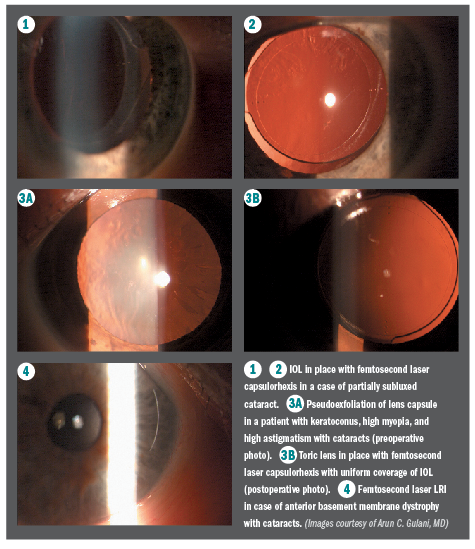Article
Could femto laser in cataract surgery become a necessity?
The financial feasibility of using only one laser for all procedures is a given. Arun C. Gulani, MD, takes this one step further, arguing that perhaps the future may hold cases in which use of the femtosecond laser is a necessity, becoming a standard-of-care concept.
Take home
The financial feasibility of using only one laser for all procedures is a given. Arun C. Gulani, MD, takes this one step further, arguing that perhaps the future may hold cases in which use of the femtosecond laser is a necessity, becoming a standard-of-care concept.

(Images courtesy of Arun C. Gulani, MD)
By Liz Meszaros; Reviewed by Arun C. Gulani, MD
Jacksonville, FL-Many surgeons predict that soon, all ocular surgery will be performed with lasers. Joining the excimer, argon, and Nd:YAG lasers-which have established their benefits in laser vision, retina, and glaucoma procedures-is the femtosecond laser, currently used in the United States for LASIK procedures.
“We know that femtosecond lasers have brought about a paradigm shift in cataract surgery,” said Arun C. Gulani, MD, founder and chief surgeon of the Gulani Vision Institute, Jacksonville, FL. “It is the wave of the future, in which lasers will do everything.
“Now that cataract femtosecond lasers have become available, the concept becomes what I have always envisioned-that an anterior segment surgeon will never have to leave the office,” said Dr. Gulani, having experience with most femtosecond lasers, years before FDA approval in the United States with his international privileges. “An anterior segment surgeon can perform all diagnostics, surgery, and real-time refractive alignment with fine tuning in one sitting in the office.”
The financial feasibility of using only one laser for all procedures is a given, but Dr. Gulani takes this one step further, arguing that perhaps the future may hold cases in which use of the femtosecond laser is a necessity, becoming a standard-of-care concept.
Cataract capability
Currently, at least four femtosecond lasers are approved in the United States for performing corneal incisions, anterior capsulotomy, limbal relaxing incisions (LRIs), and lens fragmentation in cataract procedures. Among the advantages the femtosecond laser brings to these procedures is an improved and consistent safety and predictability profile.
“The femtosecond laser right now does our incision, astigmatism LRIs, capsulorhexis, and lens fragmentation,” Dr. Gulani said. “The concept here is, in cases such as pseudoexfoliation of the capsule, minimally subluxed cataracts, and mature cataracts, doing the capsulorhexis is the Achilles’ heel of the eye surgeon. No matter how gifted we are, this is where we get worried because the capsule may just tear in the wrong direction and then the case is out of control.
“In these cases, having something as reliable, consistent, and predictable as the femtosecond laser literally takes the edge away because once you have a great rhexis in a mature cataract, not only does it set your stage, but it also decompresses the capsular bag to avoid the ‘Argentinian flag sign’ as an ominous sign of impending disaster,” he said.
In pseudoexfoliation, it makes it much more controlled and safe.
“Similarly, in partial subluxed cataract as well, it could give you a perfect rhexis so you align t to the lens and plan perhaps a capsular tension ring, for example, and then you are done, he added.
“These are cases where I feel literally that using a femtosecond laser becomes mandated with today’s availability of femtosecond lasers. But could not doing it with femtosecond laser be considered a lack of standard of care?” he posited.
Lesser indications that could mandate a femtosecond laser include cases of anterior corneal dystrophy and Fuch’s dystrophy, where the creation of LRIs could rip the loose epithelium (abrading of the epithelium) so the patient then may complain of foreign body sensation next day, despite a perfect cataract surgery and vision outcome.
“In these cases, what is beautiful with the femtosecond laser is that it creates the incision intrastromally,” Dr. Gulani said. “The epithelium is therefore tightly apposed and mostly intact, the LRIs are done predictably and can be opened next day in a controlled fashion with a specifically designed instrument.”
He is currently designing a femtosecond laser cataract instrument set to this end in collaboration with Bausch + Lomb.
Case report

Dr. Gulani
Dr. Gulani reviewed one of his cases in which the use of the femtosecond laser was particularly beneficial. A 58-year-old male was referred to him with stable keratoconus, high astigmatism, pseudoexfoliation, cataract, and high myopia. By including the use of the femtosecond laser, Dr. Gulani was able to provide exact, consistent, and predictable treatment for this otherwise challenging case.
“Involving the femtosecond laser made my course so much easier, because I wasn’t worried about the patient’s pseudoexfoliation in a very deep anterior chamber, and I could accurately plan the rhexis for my two opposing desires-one to have a rhexis large enough to flip the cataract out of the bag and emulsify in the anterior chamber, and second to have it small enough to have a rim around the entire lens implant to maintain a stable and snug, rotation-free atmosphere for this toric lens with high astigmatism responsibility,” he explained.
“Surely, I could have managed this case like many others before him using my handheld instruments,” Dr. Gulani concluded. “But with the availability of the femtosecond laser today, I felt as if I would have deprived him of what could be considered his ‘right of way.’”
Suggested reading
Gulani AC. Femtosecond Laser in Cataract Surgery: Designer Cataract Surgery. Textbook of Femtosecond Laser: Technology & Techniques. 1st ed. J.P. Publishers 2012;20:152-154.
Donnenfeld E, Gulani AC. Femtosecond Laser for Astigmatism Correction during Cataract Surgery.Textbook of Femtosecond Laser: Technology & Techniques. 1st ed. J.P. Publishers; 2012;21:155-161.
Bansal J, Gulani AC. Excimer laser enhancements after multifocal IOLs. In: Hovanesian J, ed. Textbook of Premium Cataract Surgery: A Step By Step Guide. 1st ed. Thorofare, NJ: Slack Inc.; 2012:135-145.
Gulani AC, Wang M. Femtosecond Laser in Ophthalmology: Past, Present and Future. Textbook of Femtosecond Laser: Technology & Techniques. 1st ed. J.P. Publishers 2012;22:162-164.
Subscribe to Ophthalmology Times to receive the latest clinical news and updates for ophthalmologists.
Newsletter
Don’t miss out—get Ophthalmology Times updates on the latest clinical advancements and expert interviews, straight to your inbox.





